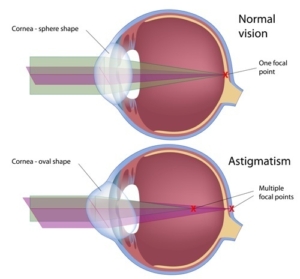Can You Treat Astigmatism During Cataract Surgery?
Do you want clearer vision with less dependence on glasses or contacts after cataract surgery? If you have cataracts and astigmatism, ordinary premium intraocular lenses or IOLs can’t correct astigmatism.
But with the help of a toric premium IOL, you can treat astigmatism during cataract surgery and achieve the best vision possible following your procedure. Keep reading to learn more about cataracts and astigmatism and why it’s possible to treat both during the same procedure.
What is a Cataract?

Cataracts occur when the natural lens becomes cloudy, impacting your ability to see clearly. Cataracts happen when the proteins in your eyes break down and clump together on your lens.
As a result, your lens turns cloudy and affects how light enters your eye, causing foggy vision. The most common cause of cataracts is aging.
Other causes include eye trauma, certain medications, too much exposure to the sun, diabetes, previous eye surgery, and high blood pressure.
Signs of Cataracts
When you have cataracts, it may feel like you’re looking at the world through a dirty window. Other signs of cataracts include:

- Blurred vision
- Halos and glare
- Light sensitivity
- Colors appearing dull or faded
- Poor night vision
- Frequent prescription changes
- Double vision in one eye
- Increased need for brighter light for close-up activities
- Second sight or temporary improvement in vision
Cataracts often develop gradually, meaning you won’t need to remove them immediately. But with time, cataracts can begin to interfere with daily activities like reading and driving and affect your overall quality of life.
If it’s become increasingly difficult to see because of cataracts, your eye doctor will recommend cataract surgery. Cataract surgery is the only way to treat cataracts and remove them. After removing a cataract, your cataract surgeon will replace it with a synthetic intraocular lens (IOL) to restore clear vision.
What is Astigmatism?

The cornea should be round, like a baseball or basketball. But when you have astigmatism, your cornea is more like the shape of a football.
Because of this, light doesn’t focus properly on your retina, leading to blurry or distorted vision at all distances. The more astigmatism you have, the blurrier or more distorted your vision gets.
You can correct astigmatism by wearing prescription glasses or contact lenses. But if you want to reduce your dependence on corrective lenses after cataract surgery, you need a toric IOL.
A toric lens implant or astigmatism-correcting IOL can permanently treat astigmatism and improve your vision.
Toric IOLs
In the past, patients had cataract surgery without addressing pre-existing astigmatism. Patients had to continue wearing contact lenses or glasses after cataract removal to see clearly.
Now, you can treat astigmatism during cataract surgery by choosing a toric intraocular lens. Toric lenses are premium implants that replace your natural lens during cataract surgery.
However, unlike other IOLs, they are specifically designed to correct astigmatism and farsightedness or nearsightedness. These IOLs counterbalance the irregular shape of a cornea with astigmatism, preventing blurred or distorted vision and bringing your world into sharper focus.
If you have a toric lens implanted in each eye for distance vision, you would still require reading glasses for up-close vision. Luckily, premium lenses of all kinds come in toric models.
You can significantly increase your freedom from glasses or contact lenses by selecting a premium IOL with a broader range of vision. For instance, by choosing a toric multifocal IOL, you can correct your astigmatism and see clearly at all distances: near, far, and everything at intermediate distances.
Cataract Surgery and Astigmatism Correction
Your cataract surgeon at Eye Consultants of North Dakota will begin by numbing your eyes with anesthetic eye drops. These drops ensure you won’t feel any pain during the procedure.
Next, the surgeon creates a small incision in your cornea. They insert a probe that breaks the natural lens into tiny pieces through this opening.
Breaking your lens into tiny fragments makes removing the cataract from your eye easier. Your cataract surgeon removes the pieces using gentle suction.
A toric IOL is placed in the same capsular bag that once held your natural lens. Finally, the incision is left to heal on its own.
No stitches are needed. The entire procedure only takes about 10 to 20 minutes to complete.
If you have cataracts in both eyes, you’ll only have cataract surgery performed on one eye at a time. Once the first eye fully heals and your vision stabilizes, you can undergo cataract surgery on the other.
Reasons to Correct Astigmatism During Cataract Surgery

If you have astigmatism, it’s best to address it during cataract surgery. Here’s why:
Reduce Astigmatism After Cataract Surgery
For many patients, astigmatism worsens following cataract surgery. Treating astigmatism during your cataract procedure will reduce this problem and allow you to see clearly while reducing your dependence on visual aids after cataract surgery.
Better Long Term Vision
As you get older, many eye conditions can begin developing. These eye conditions may lead to worsening vision if you have astigmatism. Correcting astigmatism during cataract surgery can improve your sight in the long term.
More Freedom
Astigmatism correction at the time of cataract surgery offers you greater freedom from glasses or contacts. Relying less on corrective lenses will allow you to return to the activities you love and live a more active lifestyle.
You’ll no longer have to worry about your contact lenses or glasses getting in the way when hiking, biking, golfing, or playing with your grandkids.
Improve Your Quality of Life with a Toric IOL

Astigmatism with cataracts makes everything around you appear more distorted and blurrier than it is. At Eye Consultants of North Dakota, our experienced team of ophthalmologists provides comprehensive treatment for cataracts and astigmatism.
We will help you see your best with proven, cutting-edge technology for cataract surgery and the most advanced toric IOLs for astigmatism. Do you have astigmatism and cataracts and want to reduce your dependence on glasses or contacts?
Schedule your cataract screening at Eye Consultants of North Dakota in Fargo, ND, to learn more about toric lenses!



